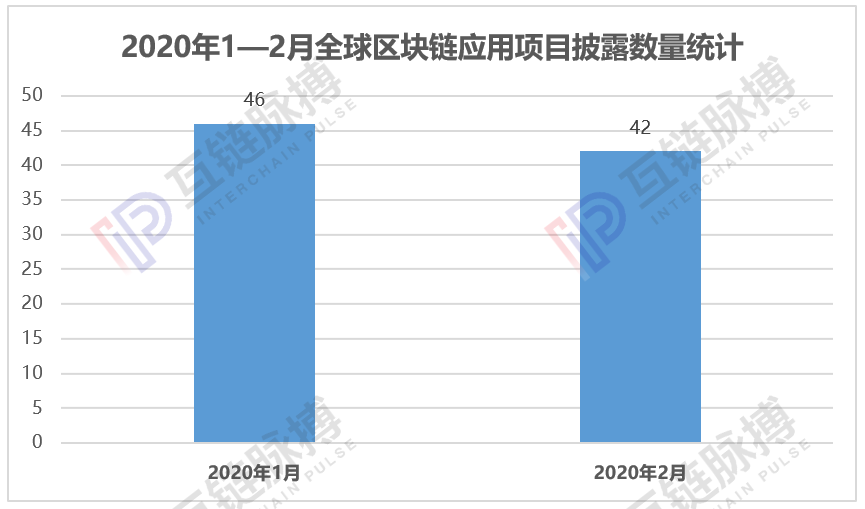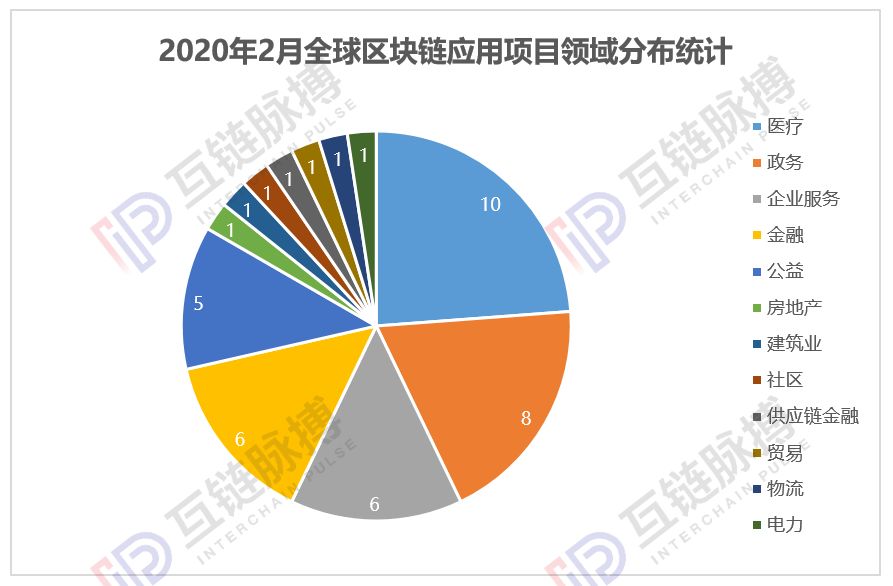Monthly Report | China discloses 37 blockchain applications in February, and the number of epidemic prevention projects accounts for over 60%
Under the epidemic situation, the domestic blockchain epidemic prevention application broke out in February.
According to incomplete statistics from the Interchain Pulse Institute (IPRI), in February 2020, a total of 42 blockchain applications were disclosed worldwide, of which 26 were epidemic prevention applications, accounting for up to 61.9%.
Judging from the geographical distribution, 37 blockchain application projects disclosed in China increased by 27.6% month-on-month. In comparison, the overseas market is rather deserted. In February, there were only five blockchain application projects disclosed abroad, including two in Japan and one each in Russia, France, and the United Arab Emirates.


From the perspective of the main types of projects, of the 42 projects in February, the number of private enterprises was the largest, followed by government departments and universities. According to the statistics of the Interlink Pulse Research Institute, of the 42 application projects, 14 are private enterprises, and 7 are government agencies and 6 are universities.
- The first emergency rate cut since the financial crisis to rescue the market, or push the crypto market back to a bull market
- Ukraine defines cryptocurrencies as intangible assets
- From single key to complex calculations: the evolution of crypto transaction hosting

From the perspective of industry distribution, the blockchain application projects disclosed in February covered 12 areas. Among them, medical and government applications are the largest, accounting for 24% and 19% respectively, followed by the three fields of corporate services, finance, and public welfare, with projects accounting for 14%, 14%, and 12% respectively. The remaining 17% of the projects are located in 7 fields including real estate, construction, supply chain finance, and trade.

In the fields of medical care, corporate services, public welfare and government affairs, blockchain applications are mainly used for epidemic prevention and control. According to statistics from the Interlink Pulse Research Institute, out of 29 projects in these four fields, 80% of them are epidemic prevention applications.
In the medical field, Xi'an Jiaotong University has urgently developed a free online health consultation, consultation and "New Crown" virus risk screening system for the Second Affiliated Hospital of Xi'an Jiaotong University. Donghua Software has established a health file and health data sharing platform based on blockchain technology, which solves the problems of comparing data of patients with the same symptoms between hospitals and sharing horizontal information about patient treatment.
In terms of enterprise services, the application of blockchain is mainly to help enterprises resume production and resume work. For example, China Unicom Research Institute, China Unicom Jiangxi Branch, and Jiangxi Industrial Internet Branch have developed the country's first blockchain-based resumption and resumption filing filing platform; in addition, Jiangsu DPEX Technology and Jiangsu Zhongxiang Jinlian Technology have also launched The intelligent public welfare software based on the blockchain-based "War Epidemic Digital Employees" was used to screen the outbreak risks of employees' return trips.
In the field of public welfare, blockchain application projects are mainly focused on material donation management, charity fund traceability, and other aspects. For example, FunChain Technology and Fosun Group, Xiong'an Group and other co-sponsored charity donation management-based traceability platforms based on alliance chain technology; Peking University's Blockchain Research Center of School of Information Science and Technology has developed and constructed a medical material donation certificate public welfare platform.
In terms of government affairs, Guangzhou Nansha District Science, Industry and Information Bureau has successively launched the Nansha District Epidemic Prevention and Control Collaborative System and the "Cloud Rework" system to help enterprises resume work and resume production. And Weitang Town, Xiangcheng District, Suzhou has also launched the "Battle of Epidemic Diseases" APP, which has helped nearly 200 companies resume work and reach production.
In addition to epidemic prevention applications, there have also been some other applications in the field of government affairs. For example, the Ministry of Finance of the People's Republic of China has launched a national PPP comprehensive information platform based on blockchain and other technologies; Aerospace Information Co., Ltd. has launched a smart government affairs integration commercial registration second approval system in Huicheng District, Huizhou City.
In addition, many typical applications in the financial sector also appeared in February. For example, China Everbright Bank Zhengzhou Branch launched the Forfaiting blockchain trading platform; Industrial Bank launched a financial service cloud platform based on blockchain and other technologies; Taiyuan Rural Credit Cooperatives launched a blockchain-based technology Electronic guarantee platform.
The Interlink Pulse Research Institute believes that although there were a large number of blockchain applications in the field of epidemic prevention in China in February, the homogeneity of these epidemic prevention projects is quite serious, and the actual application situation needs to be further verified. On the other hand, a large number of blockchain companies have gathered for epidemic prevention applications, which also shows that the entire blockchain industry is in urgent need of finding a scenario where large-scale applications can land.
We will continue to update Blocking; if you have any questions or suggestions, please contact us!
Was this article helpful?
93 out of 132 found this helpful
Related articles
- Pain points, trends, and competition patterns-five questions and five answers to blockchain electronic invoices
- Facebook considers redesigning Libra for regulatory approval
- Xiao Lei: The United States urgently cuts interest rates to deal with the crisis, how to prevent ordinary people from being "cut leek"
- Grayscale Investment CEO: CBDC validates value proposition of digital currency
- Case study: How to create a synthetic trading pair?
- Bitcoin's privacy dilemma: can it be 100% anonymous?
- Opinion | Members of the Korean Financial Services Commission: Lack of actual use is the biggest obstacle to the development of cryptocurrencies






